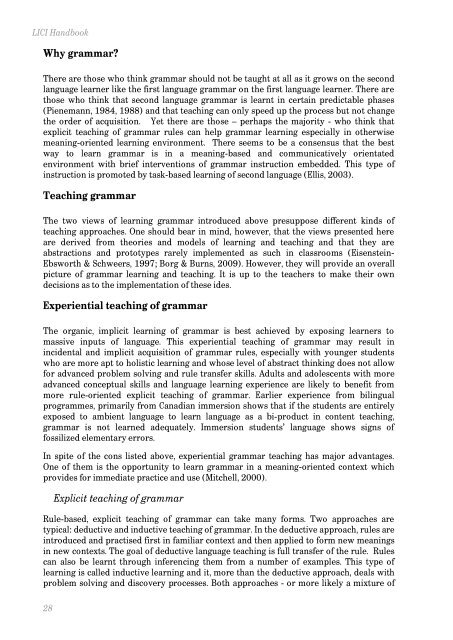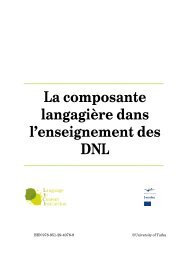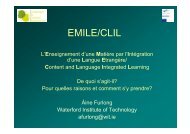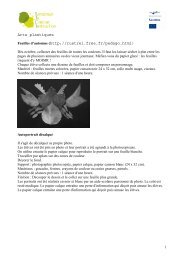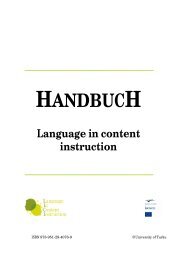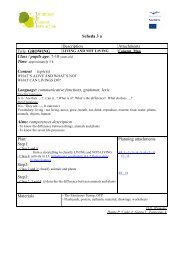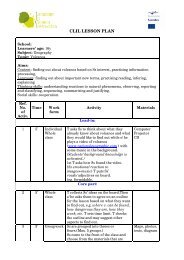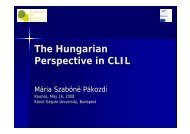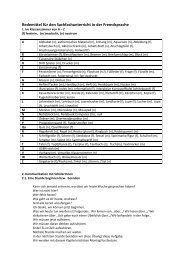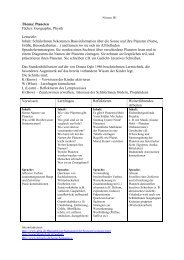Language in content instruction - LICI Project
Language in content instruction - LICI Project
Language in content instruction - LICI Project
Create successful ePaper yourself
Turn your PDF publications into a flip-book with our unique Google optimized e-Paper software.
<strong>LICI</strong> Handbook<br />
Why grammar?<br />
There are those who th<strong>in</strong>k grammar should not be taught at all as it grows on the second<br />
language learner like the first language grammar on the first language learner. There are<br />
those who th<strong>in</strong>k that second language grammar is learnt <strong>in</strong> certa<strong>in</strong> predictable phases<br />
(Pienemann, 1984, 1988) and that teach<strong>in</strong>g can only speed up the process but not change<br />
the order of acquisition. Yet there are those – perhaps the majority - who th<strong>in</strong>k that<br />
explicit teach<strong>in</strong>g of grammar rules can help grammar learn<strong>in</strong>g especially <strong>in</strong> otherwise<br />
mean<strong>in</strong>g-oriented learn<strong>in</strong>g environment. There seems to be a consensus that the best<br />
way to learn grammar is <strong>in</strong> a mean<strong>in</strong>g-based and communicatively orientated<br />
environment with brief <strong>in</strong>terventions of grammar <strong>in</strong>struction embedded. This type of<br />
<strong>in</strong>struction is promoted by task-based learn<strong>in</strong>g of second language (Ellis, 2003).<br />
Teach<strong>in</strong>g grammar<br />
The two views of learn<strong>in</strong>g grammar <strong>in</strong>troduced above presuppose different k<strong>in</strong>ds of<br />
teach<strong>in</strong>g approaches. One should bear <strong>in</strong> m<strong>in</strong>d, however, that the views presented here<br />
are derived from theories and models of learn<strong>in</strong>g and teach<strong>in</strong>g and that they are<br />
abstractions and prototypes rarely implemented as such <strong>in</strong> classrooms (Eisenste<strong>in</strong>-<br />
Ebsworth & Schweers, 1997; Borg & Burns, 2009). However, they will provide an overall<br />
picture of grammar learn<strong>in</strong>g and teach<strong>in</strong>g. It is up to the teachers to make their own<br />
decisions as to the implementation of these ides.<br />
Experiential teach<strong>in</strong>g of grammar<br />
The organic, implicit learn<strong>in</strong>g of grammar is best achieved by expos<strong>in</strong>g learners to<br />
massive <strong>in</strong>puts of language. This experiential teach<strong>in</strong>g of grammar may result <strong>in</strong><br />
<strong>in</strong>cidental and implicit acquisition of grammar rules, especially with younger students<br />
who are more apt to holistic learn<strong>in</strong>g and whose level of abstract th<strong>in</strong>k<strong>in</strong>g does not allow<br />
for advanced problem solv<strong>in</strong>g and rule transfer skills. Adults and adolescents with more<br />
advanced conceptual skills and language learn<strong>in</strong>g experience are likely to benefit from<br />
more rule-oriented explicit teach<strong>in</strong>g of grammar. Earlier experience from bil<strong>in</strong>gual<br />
programmes, primarily from Canadian immersion shows that if the students are entirely<br />
exposed to ambient language to learn language as a bi-product <strong>in</strong> <strong>content</strong> teach<strong>in</strong>g,<br />
grammar is not learned adequately. Immersion students’ language shows signs of<br />
fossilized elementary errors.<br />
In spite of the cons listed above, experiential grammar teach<strong>in</strong>g has major advantages.<br />
One of them is the opportunity to learn grammar <strong>in</strong> a mean<strong>in</strong>g-oriented context which<br />
provides for immediate practice and use (Mitchell, 2000).<br />
28<br />
Explicit teach<strong>in</strong>g of grammar<br />
Rule-based, explicit teach<strong>in</strong>g of grammar can take many forms. Two approaches are<br />
typical: deductive and <strong>in</strong>ductive teach<strong>in</strong>g of grammar. In the deductive approach, rules are<br />
<strong>in</strong>troduced and practised first <strong>in</strong> familiar context and then applied to form new mean<strong>in</strong>gs<br />
<strong>in</strong> new contexts. The goal of deductive language teach<strong>in</strong>g is full transfer of the rule. Rules<br />
can also be learnt through <strong>in</strong>ferenc<strong>in</strong>g them from a number of examples. This type of<br />
learn<strong>in</strong>g is called <strong>in</strong>ductive learn<strong>in</strong>g and it, more than the deductive approach, deals with<br />
problem solv<strong>in</strong>g and discovery processes. Both approaches - or more likely a mixture of


